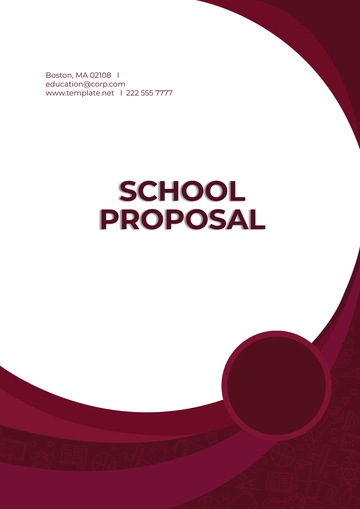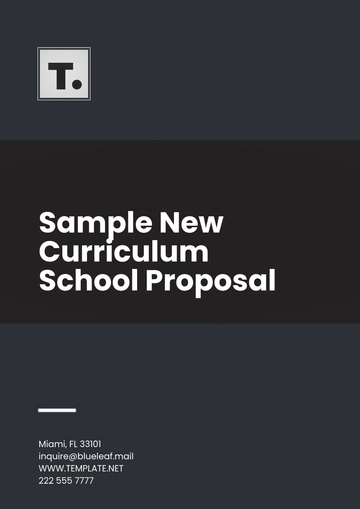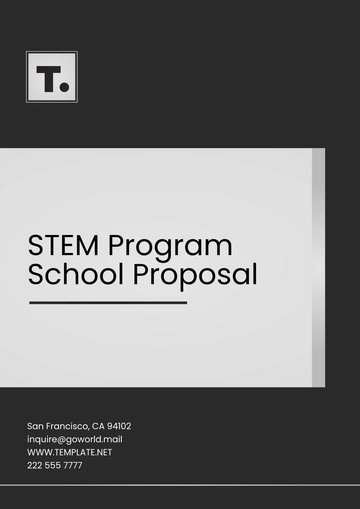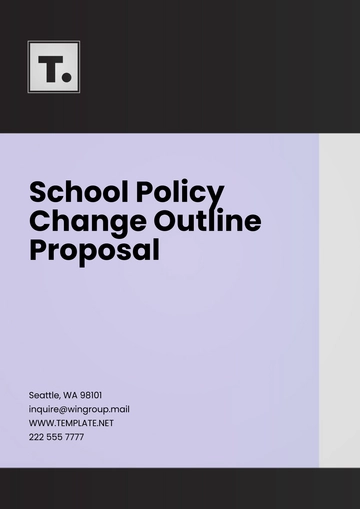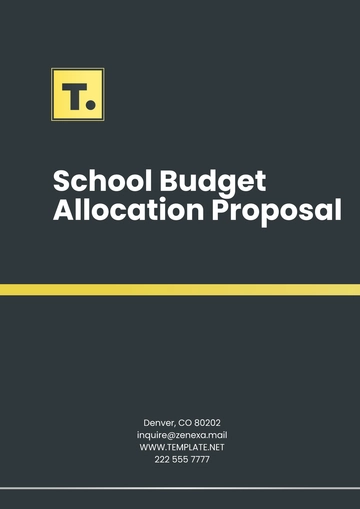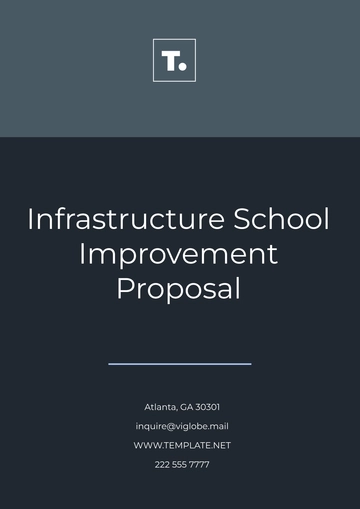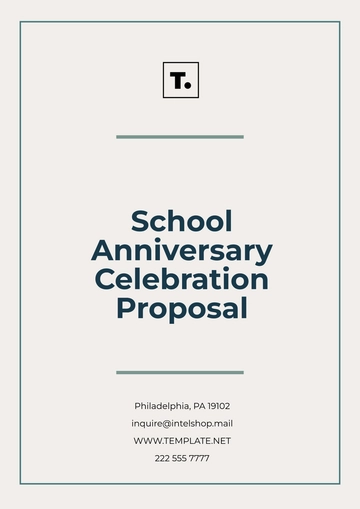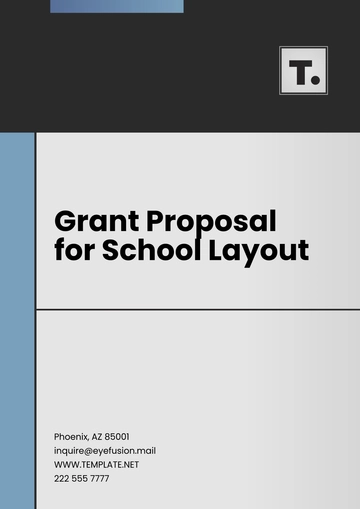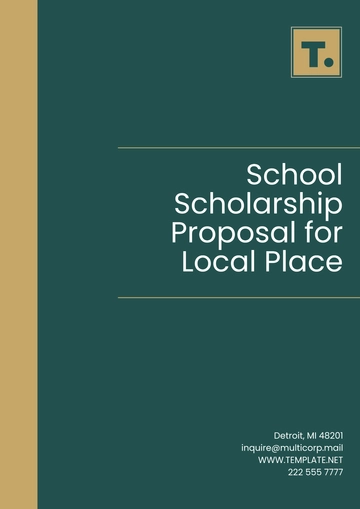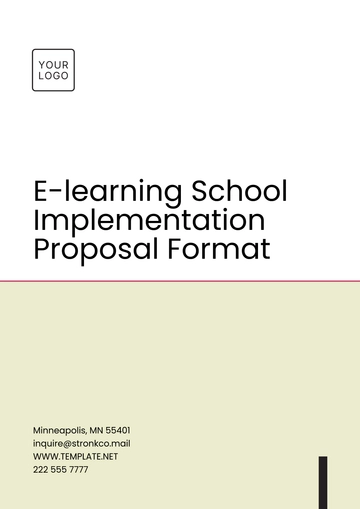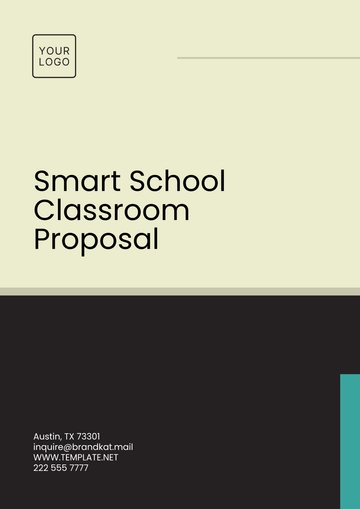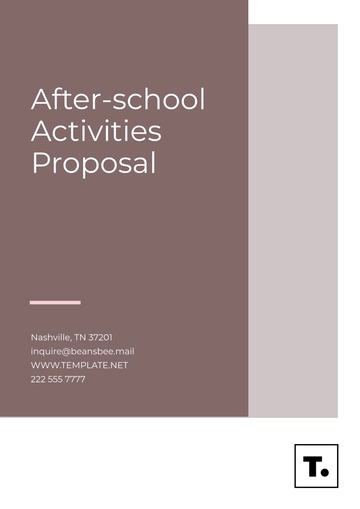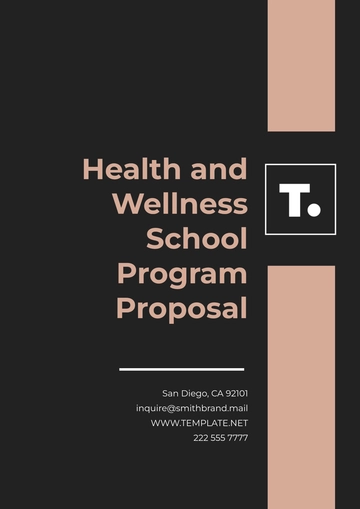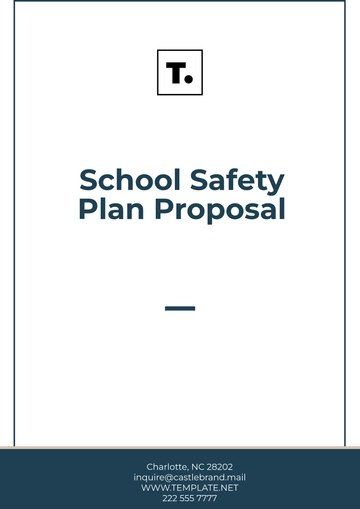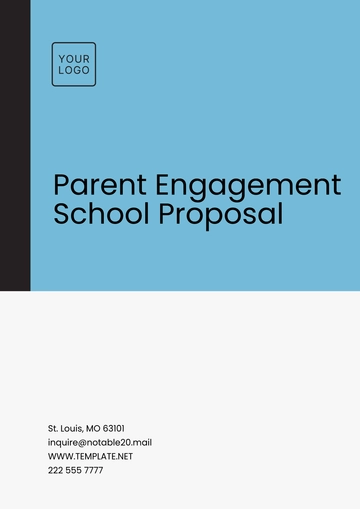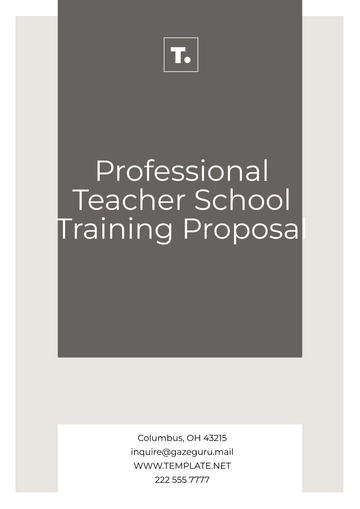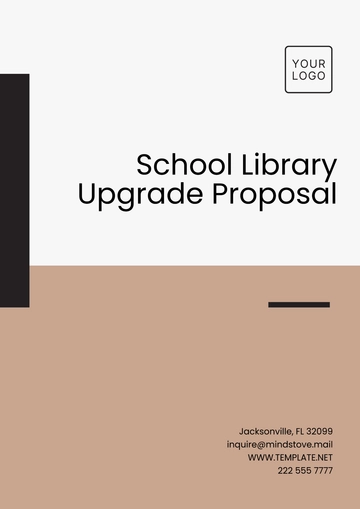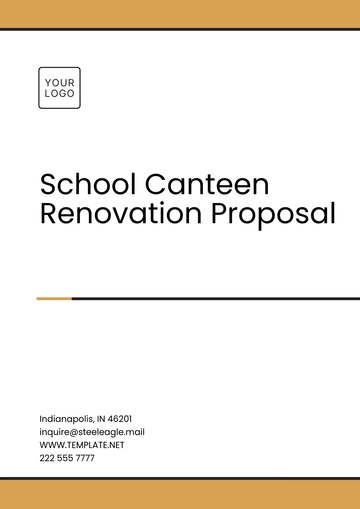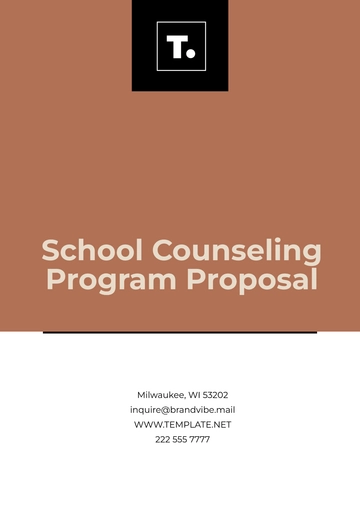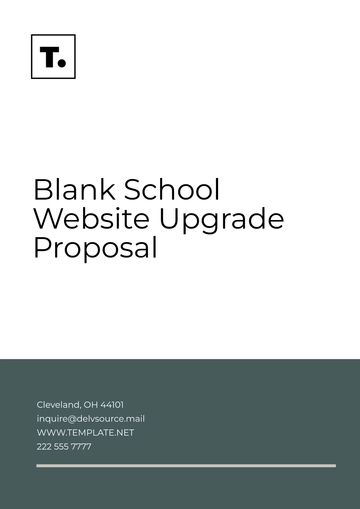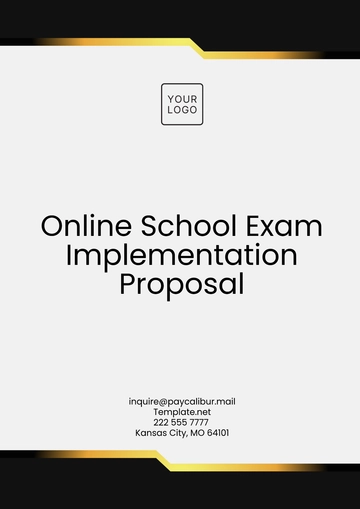Free School Board Proposal
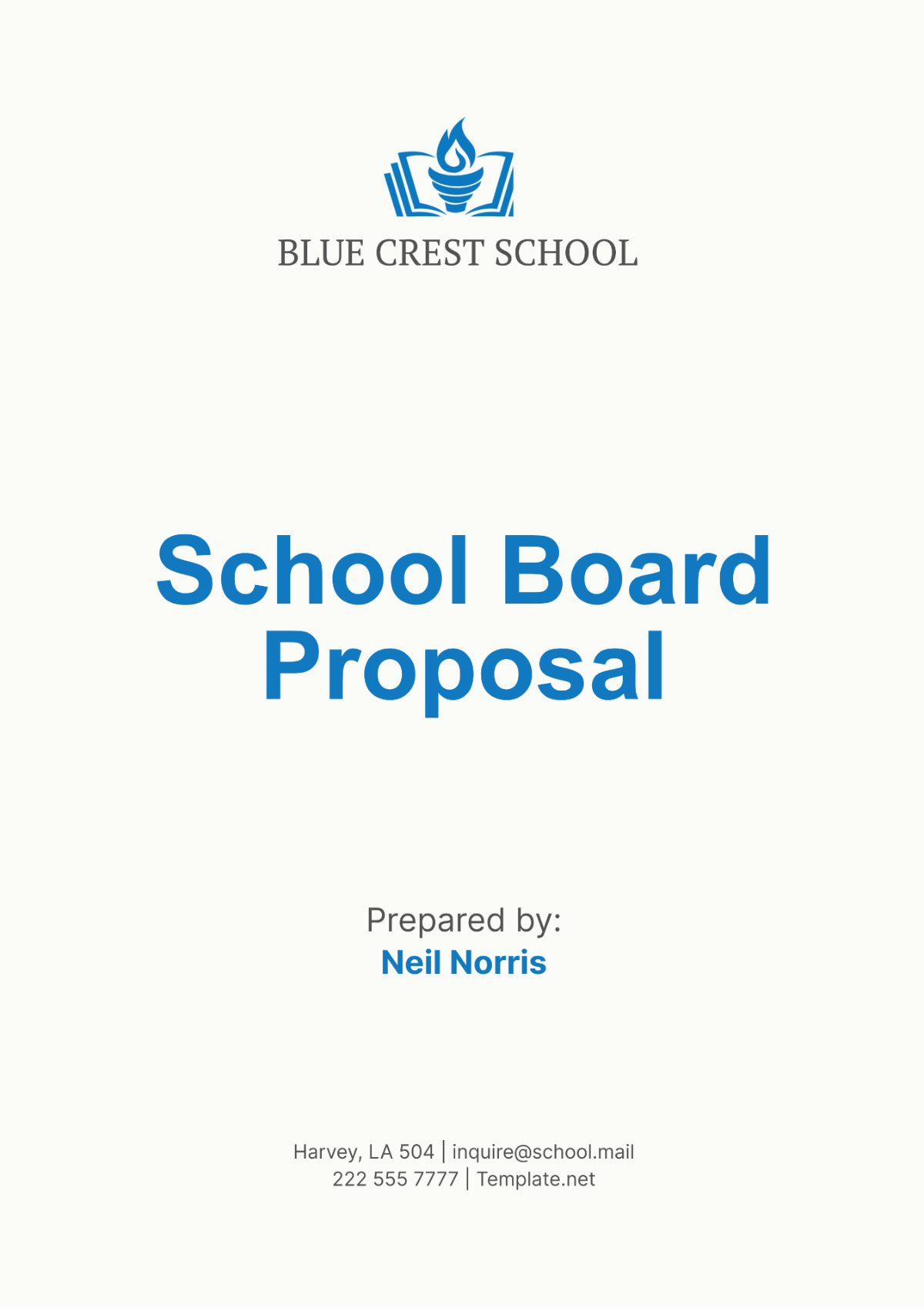
I. Executive Summary
This School Board Proposal of [Your Company Name] aims to introduce comprehensive enhancements to our educational programs, facilities, and overall school environment. Our primary objective is to foster a more conducive learning atmosphere that supports both students' academic growth and their social development. This proposal outlines key initiatives and improvements that will drive the school towards achieving these goals over the next academic year.
Our strategic initiatives focus on curriculum development, technology integration, infrastructure upgrades, and enhanced extracurricular programs. By incorporating modern educational tools and methodologies, we intend to equip our students with the necessary skills to thrive in a rapidly evolving world. Additionally, we aim to improve the physical environment of the school to create a safer and more engaging space for learning.
The total budget required for these initiatives is estimated at $580,000. This budget will cover costs associated with new technology, facility renovations, teacher training programs, and the expansion of extracurricular activities. The proposed enhancements are expected to benefit all stakeholders, including students, parents, teachers, and the broader community.
II. Educational Program Enhancements
A. Curriculum Development
Revise Existing Curriculum: Conduct a thorough review and update of the current curriculum to ensure it meets modern educational standards. This will involve input from educators, students, and subject matter experts.
Introduce New Courses: Develop and implement new courses that address emerging fields such as computer science, environmental studies, and global citizenship. This will provide students with a broader and more relevant education.
Enhance STEM Education: Strengthen the focus on Science, Technology, Engineering, and Mathematics (STEM) by incorporating hands-on projects and real-world applications. This will help students develop critical thinking and problem-solving skills.
Integrate Arts and Humanities: Ensure a balanced curriculum by integrating arts and humanities alongside STEM subjects. This will foster creativity and cultural awareness among students.
Continuous Assessment: Implement continuous assessment methods to track student progress and provide timely feedback. This will help in identifying areas where students need additional support.
B. Teacher Training
Professional Development Workshops: Organize regular workshops for teachers to enhance their teaching skills and stay updated with the latest educational trends. This will ensure that teachers are well-equipped to deliver high-quality education.
Collaborative Learning Communities: Establish learning communities where teachers can share best practices, resources, and strategies. This will promote a culture of continuous improvement and collaboration.
Mentorship Programs: Pair experienced teachers with new educators to provide guidance and support. This will help new teachers acclimate and excel in their roles.
Technology Training: Provide training on the effective use of educational technology in the classroom. This will enhance teaching methods and improve student engagement.
C. Extracurricular Activities
Expand Sports Programs: Introduce new sports programs and improve existing facilities to encourage physical fitness and teamwork. This will provide students with more opportunities to participate in athletics.
Arts and Culture Clubs: Establish clubs focused on various forms of arts and culture, including music, drama, and visual arts. This will nurture students' creative talents.
Academic Clubs: Create clubs dedicated to subjects like math, science, and literature to foster academic interest and excellence. This will provide students with additional learning opportunities outside the classroom.
Community Service Projects: Encourage students to participate in community service projects to develop a sense of responsibility and civic engagement. This will help students build empathy and leadership skills.
III. Technology Integration
The following table outlines the planned technology upgrades for classrooms:
Technology | Quantity | Estimated Cost | Purpose |
|---|---|---|---|
Interactive Whiteboards | 20 | $100,000 | Enhance interactive learning and engagement |
Tablets | 100 | $50,000 | Provide individual learning tools for students |
Laptops | 50 | $75,000 | Equip teachers with advanced teaching aids |
Wi-Fi Upgrades | $25,000 | Improve internet connectivity school-wide | |
Educational Software | $30,000 | Access to digital resources and learning platforms | |
Total | $280,000 |
A. Interactive Whiteboards
Enhance Learning: Interactive whiteboards will transform traditional lessons into interactive sessions, fostering greater student engagement and participation. Teachers can use these tools to create dynamic presentations and collaborative activities.
Support Diverse Learning Styles: These boards cater to various learning styles, making it easier for visual, auditory, and kinesthetic learners to grasp concepts. This will lead to a more inclusive and effective teaching approach.
Facilitate Teacher-Student Interaction: The use of interactive whiteboards will enhance teacher-student interaction, allowing for real-time feedback and discussions. This will make lessons more engaging and effective.
B. Tablets
Personalized Learning: Tablets will provide students with access to a wide range of digital resources, enabling personalized learning experiences. Students can work at their own pace and access additional support as needed.
Improve Digital Literacy: Providing tablets will improve students' digital literacy, a critical skill in today's technology-driven world. Students will become proficient in using digital tools for research, collaboration, and creativity.
Access to Educational Apps: Tablets will allow students to use various educational apps that enhance learning through interactive content and games. This will make learning more enjoyable and effective.
C. Laptops for Teachers
Enhance Lesson Planning: Laptops will enable teachers to plan lessons more effectively, using digital tools to create interactive and engaging content. This will lead to better-prepared and more impactful lessons.
Streamline Administrative Tasks: Laptops will help teachers manage administrative tasks more efficiently, allowing them to focus more on teaching and student interaction. This will improve overall productivity and job satisfaction.
Facilitate Professional Development: Teachers can use laptops to access online professional development courses and resources, staying updated with the latest educational trends and methodologies. This will enhance their teaching skills and knowledge.
D. Wi-Fi Upgrades
Ensure Reliable Connectivity: Upgrading the school's Wi-Fi infrastructure will ensure reliable and high-speed internet access throughout the campus. This will support the seamless use of technology in the classroom.
Support Online Learning: Improved Wi-Fi connectivity will facilitate online learning and access to digital resources, enhancing the overall educational experience. Students and teachers will benefit from uninterrupted internet access.
Enable Collaboration: Reliable Wi-Fi will support collaborative projects and communication tools, allowing students and teachers to work together more effectively. This will foster a more connected and interactive learning environment.
E. Educational Software
Access to Digital Resources: Investing in educational software will provide access to a vast range of digital resources, including e-books, videos, and interactive content. This will enhance the learning experience and support diverse learning needs.
Facilitate Assessment and Feedback: Educational software will include tools for assessment and feedback, enabling teachers to track student progress and provide timely support. This will improve learning outcomes and student performance.
Enhance Engagement: The use of educational software will make learning more engaging and interactive, keeping students motivated and interested in their studies. This will lead to better retention and understanding of concepts.
Integrating technology into classrooms will revolutionize the teaching and learning experience at [Your Company Name]. Interactive whiteboards will transform traditional lessons into interactive sessions, fostering greater student engagement. Tablets and laptops will empower both students and teachers with modern tools to enhance their educational experience. Upgraded Wi-Fi infrastructure and educational software will ensure seamless access to digital resources, making learning more efficient and effective.
IV. Facility Renovations
A. Classroom Renovations
Modernize Classrooms: Renovate classrooms with new furniture, improved lighting, and ergonomic designs to create a comfortable and stimulating learning environment. This will enhance student focus and productivity.
Upgrade HVAC Systems: Improve heating, ventilation, and air conditioning systems to ensure a healthy and comfortable indoor climate. This will contribute to the overall well-being of students and staff.
Install Smart Boards: Replace traditional blackboards with smart boards to integrate technology into everyday lessons. This will modernize teaching methods and make learning more interactive.
Create Flexible Learning Spaces: Design classrooms with flexible seating arrangements and movable furniture to support various teaching and learning styles. This will encourage collaboration and adaptability.
B. Common Areas
Library Upgrade: Renovate the school library to include modern seating, digital resources, and collaborative spaces. This will create a hub for research and group study.
Cafeteria Renovation: Update the cafeteria with new furniture, improved kitchen facilities, and a healthier menu. This will provide a pleasant dining experience for students and staff.
Outdoor Spaces: Enhance outdoor areas with seating, landscaping, and recreational facilities to encourage outdoor learning and activities. This will provide students with a healthy and engaging environment.
Restroom Upgrades: Renovate restrooms to ensure cleanliness, functionality, and accessibility. This will improve the overall hygiene and comfort for everyone.
V. Extracurricular Programs
A. Sports Programs
Expand Sports Offerings: Introduce new sports such as swimming, tennis, and track and field to diversify athletic opportunities. This will cater to a wider range of interests and abilities.
Upgrade Sports Facilities: Invest in modern sports equipment and upgrade existing facilities to meet current standards. This will enhance the quality of training and competitions.
Hire Qualified Coaches: Employ experienced and certified coaches to lead the sports programs. This will ensure professional training and development for students.
Organize Competitions: Host inter-school competitions and tournaments to encourage participation and showcase talents. This will build school spirit and healthy competition.
Promote Inclusive Sports: Develop programs that include adaptive sports for students with disabilities. This will ensure that all students have the opportunity to participate in athletic activities.
B. Arts and Culture Programs
Music Program Expansion: Enhance the music program by adding more instruments, classes, and performance opportunities. This will nurture musical talents and interests among students.
Drama and Theater: Establish a robust drama and theater program with regular productions and workshops. This will develop students' acting skills and confidence.
Visual Arts: Provide more resources and space for visual arts, including painting, sculpture, and digital art. This will support creativity and artistic expression.
Cultural Festivals: Organize cultural festivals and events to celebrate diversity and promote cultural understanding. This will foster a sense of community and appreciation for different cultures.
VI. Community Engagement
A. Parent Involvement
Parent Workshops: Offer workshops for parents on various topics, including child development, academic support, and digital literacy. This will equip parents with the tools to support their children's education.
Volunteer Programs: Encourage parents to volunteer in school activities and events. This will strengthen the school-community relationship and provide valuable support.
Parent-Teacher Conferences: Schedule regular parent-teacher conferences to discuss student progress and address any concerns. This will ensure open communication and collaboration.
Parent Advisory Committee: Establish a committee of parents to provide feedback and suggestions on school policies and programs. This will involve parents in decision-making processes.
B. Community Partnerships
Local Business Collaborations: Partner with local businesses to provide resources, sponsorships, and internship opportunities for students. This will enhance practical learning experiences and community support.
University Partnerships: Collaborate with nearby universities to offer advanced courses, dual enrollment programs, and academic support. This will provide students with access to higher education resources.
Community Service: Organize community service projects that involve students, staff, and local organizations. This will promote civic engagement and social responsibility.
Guest Speaker Series: Invite professionals and experts from various fields to speak at school events and classes. This will provide students with real-world insights and inspiration.
VII. Budget Breakdown
The following chart and table provide the detailed breakdown of the estimated budget for the proposed initiatives:
Category | Estimated Cost | Description |
|---|---|---|
Curriculum Development | $100,000 | Updating curriculum and introducing new courses |
Teacher Training | $50,000 | Professional development and training programs |
Technology Integration | $280,000 | Classroom technology and infrastructure upgrades |
Facility Renovations | $100,000 | Renovation of classrooms and common areas |
Extracurricular Programs | $50,000 | Expansion of sports, arts, and cultural programs |
Total | $580,000 |
A. Curriculum Development
Cost Allocation: $100,000 is allocated for revising the existing curriculum, introducing new courses, and enhancing STEM education. This will ensure a comprehensive and modern educational program.
Justification: Investing in curriculum development will keep our educational offerings up-to-date and relevant, preparing students for future challenges.
B. Teacher Training
Cost Allocation: $50,000 is allocated for professional development workshops, collaborative learning communities, and technology training. This will enhance the quality of teaching.
Justification: Providing continuous training for teachers will ensure they have the skills and knowledge to deliver high-quality education and adapt to new teaching methods.
C. Technology Integration
Cost Allocation: $200,000 is allocated for purchasing interactive whiteboards, tablets, laptops, and upgrading Wi-Fi infrastructure. This will integrate modern technology into the learning environment.
Justification: Integrating technology in classrooms will enhance interactive learning, improve digital literacy, and support personalized education.
D. Facility Renovations
Cost Allocation: $100,000 is allocated for renovating classrooms, common areas, and improving HVAC systems. This will create a better physical environment for learning.
Justification: Upgrading facilities will provide a comfortable, safe, and modern space conducive to effective teaching and learning.
E. Extracurricular Programs
Cost Allocation: $50,000 is allocated for expanding sports programs, arts and culture clubs, and community service projects. This will enrich students' overall educational experience.
Justification: Supporting extracurricular activities will promote holistic development, physical fitness, creativity, and community engagement among students.
The detailed budget breakdown highlights the allocation of funds across various critical areas, ensuring that all aspects of the school are adequately supported. Investing in curriculum development and teacher training will directly enhance educational quality. Technology integration and facility renovations will modernize the learning environment, while expanding extracurricular programs will offer students well-rounded experiences. This comprehensive approach ensures that all components of the school are enhanced to provide the best possible education.
VIII. Implementation Plan
A. Timeline
The following table outlines the proposed timeline for implementing the initiatives outlined in this proposal:
Initiative | Start Date | End Date | Milestones |
|---|---|---|---|
Curriculum Development | July 1, 2054 | December 31, 2054 | Completion of curriculum revisions |
Teacher Training | August 1, 2054 | June 30, 2055 | Completion of all scheduled workshops |
Technology Integration | September 1, 2054 | March 31, 2055 | Installation of all technology upgrades |
Facility Renovations | June 1, 2054 | August 31, 2054 | Completion of all renovation projects |
Extracurricular Programs | July 1, 2054 | June 30, 2055 | Launch of new programs and activities |
A. Curriculum Development
Timeline: The curriculum development will start on July 1, 2054, and end on December 31, 2054. Key milestones include the completion of curriculum revisions and introduction of new courses.
Coordination: A team of educators and subject matter experts will be formed to oversee the curriculum review and development process. Regular meetings will be scheduled to ensure timely progress.
B. Teacher Training
Timeline: Teacher training programs will start on August 1, 2054, and continue until June 30, 2055. Milestones include the completion of all scheduled workshops and training sessions.
Execution: Training sessions will be conducted by external experts and experienced educators. The training calendar will be shared with all teachers in advance.
C. Technology Integration
Timeline: Technology upgrades will commence on September 1, 2054, and conclude by March 31, 2055. Key milestones include the installation of interactive whiteboards, tablets, and laptops.
Management: A dedicated team will be responsible for coordinating with vendors, overseeing installations, and providing training on the new technology.
D. Facility Renovations
Timeline: Facility renovations will begin on June 1, 2054, and be completed by August 31, 2054. This timeline ensures that renovations are done during the summer break to minimize disruption.
Oversight: The school’s facilities management team will oversee the renovation projects, ensuring that all work is completed to the required standards and on schedule.
E. Extracurricular Programs
Timeline: Expansion of extracurricular programs will start on July 1, 2054, and continue until June 30, 2055. Key milestones include the launch of new sports, arts, and cultural activities.
Coordination: Program coordinators will be appointed to manage the different extracurricular activities, ensuring smooth execution and maximum student participation.
The implementation plan outlines a detailed timeline for each initiative, ensuring that all projects are completed efficiently and effectively. Regular progress checks and coordination among different teams will ensure that milestones are met, and any challenges are promptly addressed. This structured approach guarantees that all proposed enhancements are successfully implemented, benefiting the entire school community.
IX. Conclusion
This School Board Proposal of [Your Company Name] presents a comprehensive plan to enhance our educational programs, facilities, and overall school environment. By focusing on curriculum development, teacher training, technology integration, and extracurricular activities, we aim to provide a well-rounded and modern education to our students. The proposed initiatives, supported by a detailed budget and implementation plan, reflect our commitment to continuous improvement and excellence in education.
The successful execution of this proposal will require the collaboration and support of all stakeholders, including students, parents, teachers, and the community. We are confident that these enhancements will significantly impact the educational experience at [Your Company Name], preparing our students for future success and fostering a vibrant and supportive school environment. We look forward to your approval and active participation in this transformative journey.
- 100% Customizable, free editor
- Access 1 Million+ Templates, photo’s & graphics
- Download or share as a template
- Click and replace photos, graphics, text, backgrounds
- Resize, crop, AI write & more
- Access advanced editor
Present your ideas effectively with the School Board Proposal Template! Available on Template.net, this template is customizable to suit various proposal requirements. Its editable format ensures you can tailor the content to your specific needs. The advanced AI Editor Tool helps ensure your ideas are well-presented to the school board!
You may also like
- Business Proposal
- Research Proposal
- Proposal Request
- Project Proposal
- Grant Proposal
- Photography Proposal
- Job Proposal
- Budget Proposal
- Marketing Proposal
- Branding Proposal
- Advertising Proposal
- Sales Proposal
- Startup Proposal
- Event Proposal
- Creative Proposal
- Restaurant Proposal
- Blank Proposal
- One Page Proposal
- Proposal Report
- IT Proposal
- Non Profit Proposal
- Training Proposal
- Construction Proposal
- School Proposal
- Cleaning Proposal
- Contract Proposal
- HR Proposal
- Travel Agency Proposal
- Small Business Proposal
- Investment Proposal
- Bid Proposal
- Retail Business Proposal
- Sponsorship Proposal
- Academic Proposal
- Partnership Proposal
- Work Proposal
- Agency Proposal
- University Proposal
- Accounting Proposal
- Real Estate Proposal
- Hotel Proposal
- Product Proposal
- Advertising Agency Proposal
- Development Proposal
- Loan Proposal
- Website Proposal
- Nursing Home Proposal
- Financial Proposal
- Salon Proposal
- Freelancer Proposal
- Funding Proposal
- Work from Home Proposal
- Company Proposal
- Consulting Proposal
- Educational Proposal
- Construction Bid Proposal
- Interior Design Proposal
- New Product Proposal
- Sports Proposal
- Corporate Proposal
- Food Proposal
- Property Proposal
- Maintenance Proposal
- Purchase Proposal
- Rental Proposal
- Recruitment Proposal
- Social Media Proposal
- Travel Proposal
- Trip Proposal
- Software Proposal
- Conference Proposal
- Graphic Design Proposal
- Law Firm Proposal
- Medical Proposal
- Music Proposal
- Pricing Proposal
- SEO Proposal
- Strategy Proposal
- Technical Proposal
- Coaching Proposal
- Ecommerce Proposal
- Fundraising Proposal
- Landscaping Proposal
- Charity Proposal
- Contractor Proposal
- Exhibition Proposal
- Art Proposal
- Mobile Proposal
- Equipment Proposal
- Student Proposal
- Engineering Proposal
- Business Proposal
